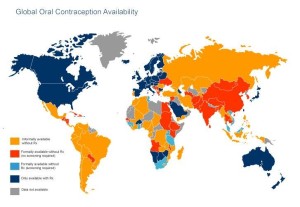As the map above shows, birth control pills are available throughout most of the world without a prescription. People in the United States are recognizing that the medicalization of contraception is not necessary, and acts as a barrier to obtaining needed contraception. Go to https://www.facebook.com/freethepill for updated information about the movement to “free the pill”.
The map below is courtesy of Ibis Reproductive Health, and comes from an article in Contraception, “Prescription requirements and over-the-counter access to oral contraceptives: a global review”, 2013.
Should you have to go to a doctor for a prescription in order to buy a medication that is safe, can prolong lives, prevents cancer and helps people feel better?
Although the press often vilifies oral contraceptives whenever a study shows that there is a risk to taking them, the reality is that they are amazingly safe. What is seldom discussed is that they have beneficial side effects. Of course, women react differently and there are many different “pillsâ€, so I cannot promise that every woman will have these benefits.
Acne is a problem for many young women, and one of the best treatments is oral contraceptives (OCs). Likewise, heavy periods, cramps and menstrual irregularity can be eased with these hormones. Because of lighter periods, pill-takers are less prone to anemia. OC users are less likely to develop benign breast cysts, ovarian cancer or cancer of the uterine lining. And, oh yes, if they are taken properly they prevent unwanted pregnancies! Remember, effective contraception has been shown to be the best way to avoid abortion.
A study of over 17,000 women in England taking OCs proved their safety. To quote the conclusion of the study: “Long-term follow-up strongly suggests that OC use slightly reduces all cause mortality.â€
What care is essential before starting on OCs? You should know your blood pressure; if it is elevated, you may not be a candidate. You definitely shouldn’t take pills that contain estrogen if you have ever had a stroke or heart attack or a blood clot in your legs. Even if you have a relative who had one of these at an early age you might want to consider another method of contraception. Women who smoke have a greater risk of all these circulatory problems whether or not they take “the pillâ€. The combination of oral contraceptives and smoking becomes dangerous in women over 35 years of age. Fortunately there are pills without estrogen (progestin only pills) that may be safe for high-risk women.
The upshot is that oral contraceptives are amazingly safe and have health benefits in addition to preventing unplanned pregnancies. Even though there is a slight risk to taking them, the risk to a woman’s life or health of carrying a pregnancy to term is much greater.
Several medications that once required prescriptions have been shown, with experience, to be safe. Ibuprofen (Advil®) and loratadine (Claritin®) are examples. Now there is a push for this transition to happen with birth control pills. The American College of Obstetricians and Gynecologists (the organization that sets the standards for my specialty) came out in favor of over-the-counter (OTC) access to oral contraceptives more than 2 years ago. They recommend that women self-select by using a checklist.
Senator Cory Gardner has introduced a bill to do just that. The major fear is that women with insurance would actually need to pay more for their birth control because currently all insurance policies pay 100%. Unfortunately, most insurance plans don’t pay anything for OTC medications. Another, better Senate bill, introduced by Senator Patty Murray of Washington State, would assure that insurance would continue to pay even if “the pill†went OTC.
For years women have had to go to a provider to get a prescription for “the pillâ€. This usually involved stripping off clothes and some needless, embarrassing exams. We now recognize that most of this ritual is unnecessary, expensive and acts as a barrier keeping many women from their needed contraception. Women have been able to go to Planned Parenthood and answer a few questions, have her BP checked and leave with her pills. Why shouldn’t a similar program be available at her local pharmacy?
How times have changed! Just 50 years ago the US Supreme Court made contraception legal to all married women. Comstock laws prevented dissemination of birth control literature or supplies before then. Congress passed the first Comstock law in 1873, with the goal of causing “suppression of trade in, and circulation of, obscene literature and articles of immoral use”. Many states passed similar laws. The last of these laws, in Connecticut and Massachusetts, were only struck down in 1965—50 years ago this month.
We are progressing slowly in this country to make safe contraception available to all who want it. Hopefully this will reduce unintended pregnancies—it is sad that now about half of all pregnancies in the USA are unintended. Their financial cost was estimated to be $21 billion in 2010! Much more distressing, however, is the psychological cost of unplanned pregnancies.
© Richard Grossman MD, 2015
